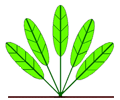


Finke Goby
Chlamydogobius japalpa
General information: The Finke Goby is one of nine species of fish found in the Finke River. The Finke Goby is listed as Vulnerable in NT threatened species legislation. The sustainable use of natural resources is a way forward for land managers to make extra income from plants and wildlife that are perhaps not suited for farming or grazing. It is also a form of conservation when a resource is valuable in its natural state and earning some income it gives the area added value. The farm gate sales of this fish will be divided between the traditional owners of Three Mile Hole on the Finke River and those responsible for the upkeep of its habitat, either the land owner or a landcare group. At the time of writing the ownership of Henbury Station is under review. The Finke Goby grows to about 6 cm, it is usually a drab mottled light olive brown. It is very well camoflaged in its habitat. They are well suited to life in the Desert with a tolerance to a wide range of water qualities. The four photos from left to right are a male in breeding colour, the same male with his lady friend, the female with eggs then a juvenile. Click on the picture to see a larger image. They are best kept in harder water with a pH about 7.5, hardness over 150 ppm and alkalinity over 80ppm. They can tolerate salinities up to or greater than seawater. The small water holes in the Desert are also subject to large fluctuations in temperature from about 5 deg to 40 deg however are best kept from about 20 deg to 25 deg. Their natural diet consists of small insects, crustaceans and algae. In captivity they can be fed minced pea and prawn puree, aquaculture crumble and other frozen foods such as bloodworms. An aquarium of 60 cm or 80 litres is about the minimum of a small group of about 6 gobies. If you put some flat stones and a piece of 15mm pvc about 100 long they will use that to lay eggs. The eggs are quite large and fry are easy to raise. The Finke Goby probably lives less than two years so you should breed your fish often and always keep some young ones growing up. There is a care sheet on the Aquagreen aqualog http://aquagreen.com.au/aqualog/?p=172 The Aquarium trade is often blamed as a threat to small native species. We hope to turn that idea around 180 degrees with the small scale low impact sustainable use of renewable natural resources as a conservation tool. This type of project uses the threatened species in a way that helps pay for its own habitat protection and was first raised in the NT by Dr raham Webb with rehabilitation of the crocodile population and then Dr David Lawson of Parks and Wildlife NT wrote Government Policy which is available on the Aquagreen web site. http://www.aquagreen.com.au/guides.html and is titled Conservation through the sustainable use of wildlife, plants are also wildife. It advocates using threatened species in a positive way that has a conservation, a social and a commercial outcome.
Distribution : This fish is only found in waterholes of the Finke River. This river flows out of the McDonald Ranges near Alice Springs in a South Easterly direction where it eventually disappears in the desert sands. It only flows after a lot of rain then returns to a series of water holes.
Selling details : Sold as individual fish over 2.5 cm
Reference: Allen, Midgley and Allen 2002 "Field Guide to the Freshwater Fishes of Australia" , ANGFA database - http://db.angfa.org.au/